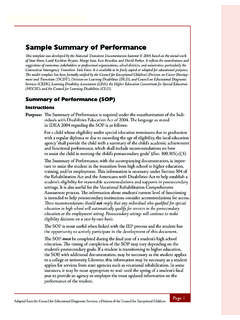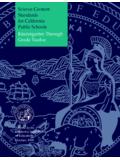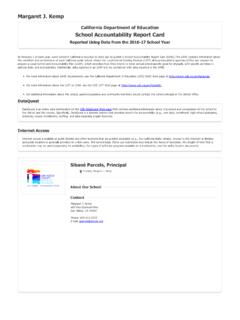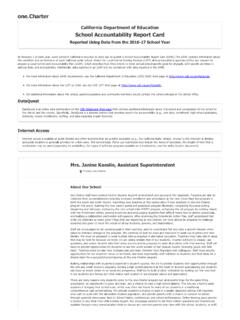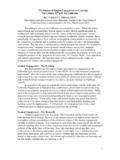Transcription of The Special ED - CalSTAT
1 U Winter-Spring 2014 Th e Sp e c i a l e Dg e: the common core State standards page 1 tA commitment to eliminating inequality is one of the principal rationales driving the california common core State standards (CCSS), according to David Coleman, a writer of the new standards and founder of Student Achievement Partners. As part of this commitment, students with disabilities .. must be challenged to excel within the general curriculum and be prepared for success in their post-school lives, including college and/or careers. 1 The standards and their promise of equity have created a great deal of excitement in some quarters and concern about the degree of necessary change in , according to Barbara Murchison, Administrator of the california Department of Education s common core Systems Implementation Office, there is a great deal about the state s standards and the system of education that remains familiar.
2 Murchison sees the Individualized Education Program (IEP) as one point of stability. The IEP, which has been in place in schools nationwide since 1975, requires teachers and parents of students with disabilities and often students themselves to meet regularly to discuss Informing and supporting parents, educators, service providers,and policymakers on topics related to Special educationVolume 27, No. 2 Winter-Spring 2014 EDgeThe Special What New standards Mean for Students with DisabilitiesCalifornia common core State Standardsand agree on specific, clear educational goals for the student what the student should know and be able to do. That, in essence, is what establishing standards is all about, says Murchison. Our parents are used to the notion of setting and achieving goals (see article page 11) so that working within a formal system of standards is hardly a new thing.
3 california first established educational standards in 1997. Yet, Murchison says, the previous standards covered so much ground. These new standards are no longer a mile wide and an inch deep. Having fewer topics at each grade allows students and teachers more time to move through material thoughtfully and carefully, to read (and reread) closely, and to spend more time building conceptual understanding, thus benefiting students who struggle to process information and students who are anxious about their ability to learn. The structure of the new standards also makes it easier to develop a coherent progression of goals. This coherence is supported, says Murchison, through multiple opportunities for students to develop a full grasp of the material the cornerstone of Universal Design for Learning (see article page 3). This issue of The Special EDge provides an overview of how instruction, the IEP, and assessments will change under the new CCSS and of how these new standards promise to create a system that improves and enhances educational benefit for all students, especially for students with disabilities.
4 TInsideUniversal Design for Learning and the common core ..3 New Assessments and the common core ..6 Professional Development and the common core ..9 The IEP and the common core ..11 Multitiered System of Supports and the common core ..16 Insert: The common core At a Glance What Parents, Students,Teachers, and School Administrators Need to Know 1. Application to Students with Disabilities. page 2 Th e Sp e c i a l e Dg e: the common core State standards Winter-Spring 2014 tEDgeFred Balcom: Director, Special Education Division, CDES teve Perez: CDE Contract Monitor and Project LiaisonStacey Wedin: CDE Editorial Consultant Anne Davin: CalSTAT Project ManagerMar y Cichy Grady: EditorGiselle Blong: Editorial AssistantGeri West: Content ConsultantJanet Mandelstam: Staff WriterDavid Rose: Contributing WriterKristen Brown: CDE ConsultantKristin Wright: CDE ConsultantThe Special EDge is published triannually by Napa County Office of Education s CalSTAT Project ( california Services for Technical Assistance and Training).
5 Funding is provided by the california Department of Education, Special Educa-tion Division, through contract number CN077046 with Napa County Office of Education (NCOE). Contents of this doc-ument do not necessarily reflect the views or policies of NCOE or the california Department of Education (CDE), nor does mention of trade names, commercial prod-ucts, or organizations imply endorsementCirculation: 51, information in this issue is in the public domain unless other wise indicated. Readers are encouraged to copy and share but to credit CalSTAT and CDE. This issue is available on disk, audiotape, and in large print upon request. By going to CalSTAT s Web site you can download PDF and text versions of this and previous newsletters. Contact The Special EDge by telephone at 707-849-2275; by e-mail at or by postal mail at The Special EDge, c/o NCOE/ CalSTAT , 5789 State Farm Drive, Suite 230, Rohnert Park, california system specifically, the State Systemic Improvement Plan now requires high-stakes measurement that goes beyond mere compliance with the law to account for a student s educational progress.
6 Together, these changes serve to propel our educational system toward increased integration and fuller alignment with the original intents of the Individuals with Disabilities Education Act (IDEA) and, even more importantly, toward improved outcomes for all students. The CCSS have changed what all students will be expected to learn and how teachers will need to teach. These changes give school administrators and teachers an opportunity to re-think and re-emphasize Special education as that constellation of supports and services primarily designed to assist students success in general education. This is their least restrictive environment (LRE). Fundamentally, Special education was never intended to be a separate place, except for those very few students with unique needs. We are charged with implementing one educational system for all students. To support success for students with disabilities in the LRE, we must improve general education practices and interventions by incorporating Universal Design for Learning (UDL) into classroom instruction and a Multitiered System of Supports (MTSS) into school and district processes, both of which serve to successfully maintain students in the LRE and result in improved outcomes.
7 Efforts to implement the various components of CCSS make even clearer the importance of aligning the Elementary and Secondary Education Act with IDEA. Both of these critical pieces of federal legislation send consistent messages that all students need equal access to quality education and quality instruction, all students must be held to high standards of achievement, and all students must be measured appropriately by statewide assessments. Further, as we assess students, we must assess them on what is taught and in the way it is taught: assessment must be directly tied to instruction. The ability of teachers to determine what students need to know next is essential to the success of any assessment. The CCSS and new statewide assessments are discussed throughout this issue, with Special inserts targeting pertinent information for parents, students, teachers, and administrators.
8 In addition, I invite you to periodically visit our Web site dedicated to providing common core resources and up-to-date information for Special educa-tors. With the numerous, ongoing changes, information sharing is critical to everyone s success. Now is the time to come together, embrace the change, and renew our commitment, energ y, and passion for serving students with disabilities. Fred BalcomCalifornia is seeing important, simultaneous changes that will significantly influence the way students with disabilities are educated. The common core State standards (CCSS) repre-sent one particularly sweeping change, as does the new assess-ment system that is being designed to measure student progress on the CCSS. In addition, the new federal Letter from the State DirectorThe common core State standards have changed what all students will be expected to learn and how teachers will need to Specialu Winter-Spring 2014 Th e Sp e c i a l e Dg e: the common core State standards page 3 tAren t the common core standards great for kids with disabilities?
9 Aren t the common core standards inaccessible? Aren t they wholly in sync with Universal Design for Learning (UDL)? Don t they conflict with the core values of UDL? W henever I talk to educators these days in Webinars and seminars, in my graduate class at Harvard, at conferences around the country the subject of the common core State standards invariably comes up. The standards always seem to get a strong reaction some love them, others hate them, and others are bewildered by what they mean for education. Few responses are discussion reminds me of the one we had around No Child Left Behind (NCLB) a decade ago. Like the common core , the principles and aspirations of NCLB were promising for students with disabilities. For too long, these students had not been included in mainstream education. NCLB welcomed students with disabilities and other at-risk learners for the first time to attain the same standards as their peers and vowed to hold schools accountable for achieving this.
10 The common core presents a similar aspiration. All good educational design begins with a clear purpose, and the common core helps define that purpose by providing a better idea of the baseline knowledge and skills we want everyone to learn. Only by clarifying our destination can we begin to map a plan. But aspirations are not enough. With NCLB, the aspirations of the law soon ran aground in its execution, especially in the ways that large-scale standardized tests were used to measure and essentially punish failing schools. The same will happen with the common core if appropriate attention is not paid to how the standards are put into practice and how they are effort to meet the needs of struggling learners by simplifying the curriculum or lowering expectations would be misguided in three ways. First, lowered expectations are rarely positive for anyone (because they usually lead to a self-fulfilling prophecy of lowered achievement), and the history of lowered expectations for students with disabilities has been especially diminishing.
